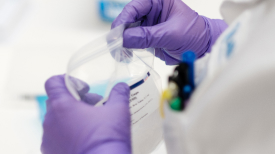- Cancer Care Team
Cancer Care Team
To deliver optimal patient outcomesProducts and Services
Cancer Type
Supplies & Tools
Scientific Focus
- Biopharma Partners
- Patients
- Education & Events
- Login
- Contact Us
Test Details
Use
This test is used for confirmation/identification of cancer-related alterations (associated with myxoid liposarcomas/round liposarcomas).
Special Instructions
There will be an additional charge for processing paraffin block samples or for samples that require culture.
Limitations
Molecular mutations or chromosomal alterations not targeted by the probe included in this profile will not be detected.
This test was developed and its performance characteristics determined by Labcorp. It has not been cleared or approved by the Food and Drug Administration.
Methodology
Fluorescence in situ hybridization (FISH)
Specimen Requirements
Information on collection, storage, and volume
Specimen
Fixed-cell pellet from a cytogenetic analysis, slides with metaphases and/or interphase nuclei or bone marrow touch prep slides; whole blood, bone marrow, cerebrospinal fluid (CSF), FNA, paraffin block are also acceptable with additional charge
Volume
5 mL whole blood (pediatric), 3 mL bone marrow, fixed-cell pellet from a cytogenetic analysis, 2 slides with metaphase and/or interphase nuclei, 2 touch preparation slides or 3 slides from paraffin block
Minimum Volume
1 mL whole blood (pediatric), 1 mL bone marrow, fixed-cell pellet from cytogenetic analysis, 1 slide with metaphase and/or interphase nuclei, 1 touch preparation slide or 2 paraffin slides (Note: Minimum volumes may not allow for repeat testing.)
Container
Green-top (sodium heparin) tube; pediatric Vacutainer® is optimal or lavender-top (EDTA) tube (suboptimal). For samples with shared karyotype (510999) and any FISH study in the same tube, EDTA is not recommended due to the growth inhibition in cell culture. Adjust tube size to sample volume to avoid heparin toxicity.
Storage Instructions
Maintain specimen at room temperature.
Causes for Rejection
Broken or dirty slides; excessive cellular debris or stained slides; decalcified bone cores; frozen specimen
Collection
Utilize sterile technique and Labcorp transport kits when possible.




